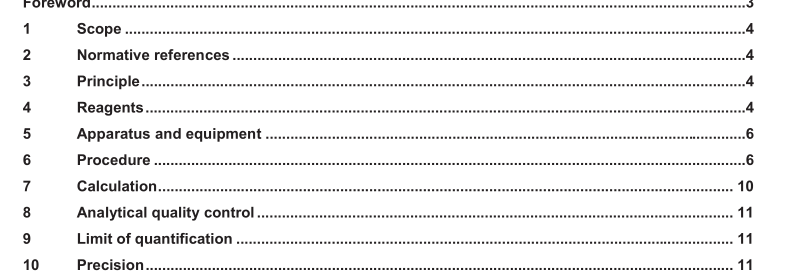EN 15763:2009 – Foodstuffs – Determination of trace elements – Determination of arsenic, cadmium, mercury and lead in foodstuffs by inductively coupled plasma mass spectrometry (ICP-MS) after pressure digestion

1 Scope
This European Standard specifies a method for the determination of arsenic, cadmium, mercury and lead in foodstuffs by inductively coupled plasma mass spectrometry (ICP-MS). The collaborative study included foodstuffs such as carrots, fish homogenate, Mushrooms (CRM), graham flour, a simulated diet E (CRM), scampi, mussel and a Tort-2 CRM having an arsenic mass fraction ranging from 0,06 mg/kg to 21,5 mg/kg dry matter (d. m.), cadmium ranging from 0,03 mg/kg to 28,3 mg/kg d. m., mercury ranging from 0,04 mg/kg to 0,56 mg/kg d. m. and lead from 0,01 mg/kg to 2,4 mg/kg d. m.
2 Normative references
The following referenced documents are indispensable for the application of this document. For dated references, only the edition cited applies. For undated references, the latest edition of the referenced document (including any amendments) applies.
EN 13805, Foodstuffs — Determination of trace elements — Pressure digestion
3 Principle
The test solution, obtained by pressure digestion, is nebulised and the aerosol transferred to a high frequency inductively coupled argon plasma. The high temperature of the plasma is used to dry the aerosol and to atomise and ionise the elements. The ions are extracted from the plasma by a set of sampler and skimmer cones and transferred to a mass spectrometer where the ions are separated by their mass/charge ratio and determined by a pulse-count and/or analogue detector. WARNING — The use of this method may involve hazardous materials, operations and equipment.
This method does not purport to address all the safety problems associated with its use. It is the responsibility of the user of this method to establish appropriate safety and health practices and determine the applicability of regulatory limitations prior to use.
4 Reagents
4.1 General The concentration of the trace elements in the reagents and water used shall be low enough not to affect the results of the determination. Using a multielemental method of high sensitivity like ICP-MS, the control of the blank levels of water and acid is very important. Generally ultrapure water and acid of high purity, e.g. cleaned by sub boil distillation, are recommended. Special facilities should be used in order to avoid contamination during the steps of preparation and measurements (e.g. use of laminar flow benches or comparable clean room facilities).
4.2 Nitric acid Mass fraction not less than w(HNO 3 ) = 65 %, with a density of approximately 1,4 g/ml.
EN 15763:2009 – Foodstuffs – Determination of trace elements – Determination of arsenic, cadmium, mercury and lead in foodstuffs by inductively coupled plasma mass spectrometry (ICP-MS) after pressure digestion